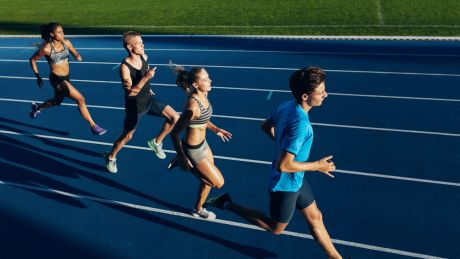Use These Beginner Track Workouts To Improve Your Running
Get faster and stronger over any distance with these simple track workouts

New runners tend to steer clear of the track, mistakenly believing it to be a place where only experienced and very fast runners train. In reality, the track is just a big circle where everyone’s welcome, and running on one once in a while can make a big difference to your performance.
To help you get started at the track we have advice and workout suggestions from Polar ambassadors Eilish McColgan, a Team GB athlete and coach at Running Made Easy, and Nick Anderson, a coach with Running With Us.
Track Workout For Beginners
When you’re looking to take your first steps on the track, the key thing to remember is that it really isn’t much different to running anywhere else and you can do the same workouts you would do on another surface.
“Start off with a session like running for a minute on [hard], minute off [easy],” says McColgan. "You can do it in the park or somewhere else first to become a bit more confident, then go to the track and do it. If you can run in the park, there’s no difference on the track, but I understand it might seem more nerve-racking.
“Build up towards running one lap, then having a one-lap recovery, and doing that six times. Then you’re doing 6 x 400m without really realising it. When you’re more confident, that can go up to 10 or 12 x 400m.”
Once you are doing intervals like this, you’ll probably realise the benefits of doing them on the track in terms of helping you to pace your efforts correctly.
“It’s much easier to do specific intervals and know exactly what time you’re clicking along at when you’re on the track,” says McColgan. “You get a good idea of what you can do and you don’t fade as much, because it’s much easier to gauge your pace.”
Sign up for workout ideas, training advice, reviews of the latest gear and more.
See related
- Marathon Training: Plans, Gear, Nutrition Advice And More
- How To Run Faster According To The Very Fast Shelayna Oskan-Clarke
- Interval Training For Runners
- 10 Week 5K Training Plan For A Personal Best
Track Workout To Improve Your Parkrun PB
Interval sessions are a must for anyone trying to get faster over 5K, so if you have a parkrun PB in your sights try this workout from Anderson.
“First have a look at your goal for your parkrun time and work out the pace per mile. Then try a session starting with one mile – four laps of the track – at threshold pace, which is a pace where you can only speak in three- to four-word bursts, and will be easier than parkrun pace.
“Then have a few minutes’ recovery before doing 4, 5 or 6 x 800m at your planned 5K race pace, with a 90-second recovery. This should feel like you’re working hard but you can control the effort over two laps.”
Track Workouts For Your Marathon Training
When it comes to training for the full 42.2km, McColgan says it’s important to not go overboard and log huge distances on the track.
“We limit track volume to 10K because if you’re not used to the track, and try and run seven or eight miles [11km to 13km] on it you’re going to be sore the next day,” says McColgan. “It’s a different surface and because you’re able to run faster, you’ll probably find your calves ache. We stick to sessions like 6 x 1 mile or 10 x 1km, both with a minute recovery.”
Anderson recommends a session running 800m reps at a mix of paces to improve your running economy – how efficiently you use fuel to power your running.
“You can do 8, 9 or 10 x 800. It’s quite a lot, but that’s only five miles [8km],” says Anderson. “Rather than doing all of the 800s hard, try to work in the running economy zone. Do the odd-numbered reps at threshold intensity, backing off a little, then for the even numbers pick it up to 5K intensity. That will make the session more interesting and ensure the overall point of the session is more about improving your running economy than bashing yourself.”

Nick Harris-Fry is a journalist who has been covering health and fitness since 2015. Nick is an avid runner, covering 70-110km a week, which gives him ample opportunity to test a wide range of running shoes and running gear. He is also the chief tester for fitness trackers and running watches, treadmills and exercise bikes, and workout headphones.
